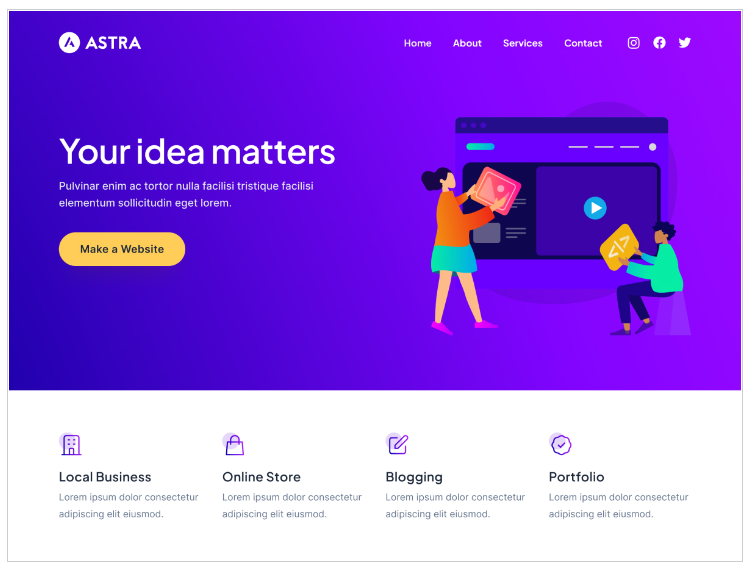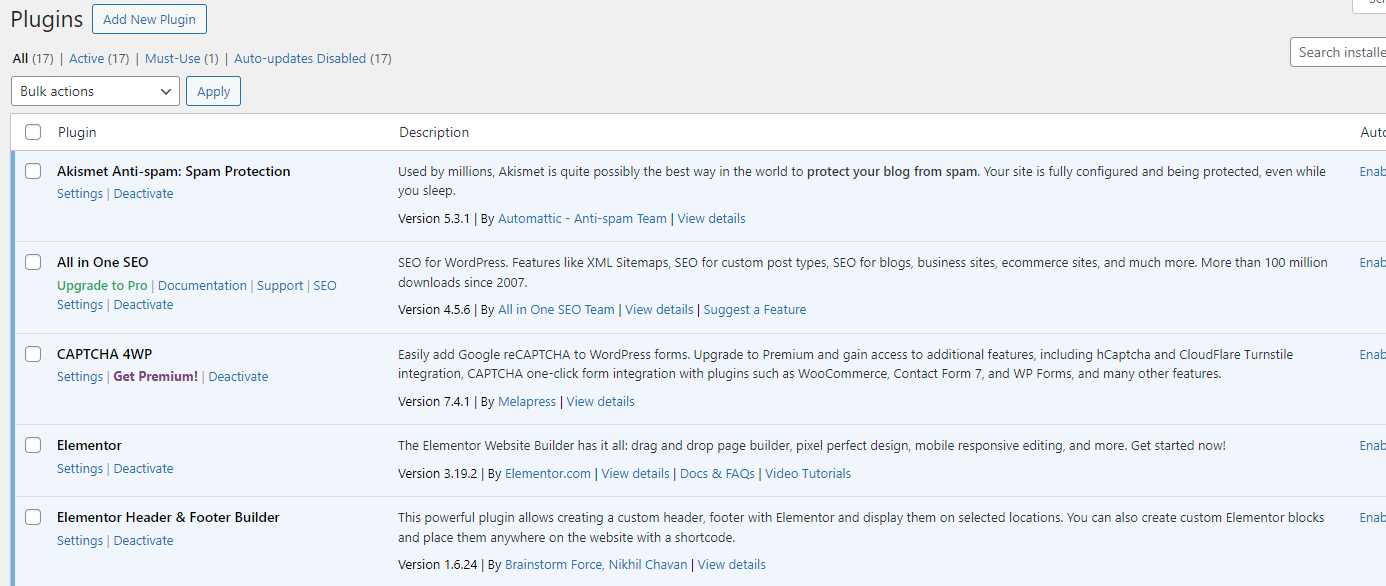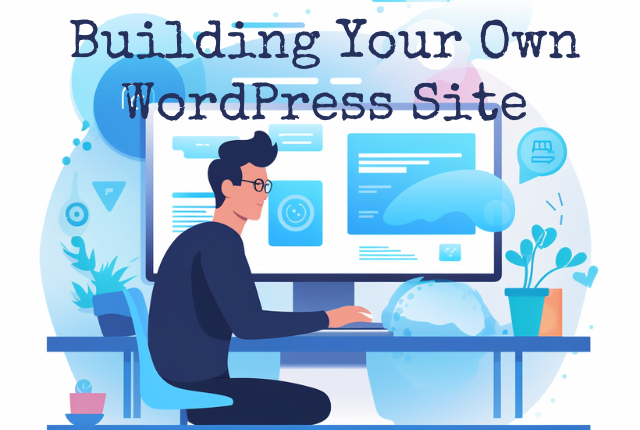Step-by-Step Guide to Creating Your WordPress Website
Creating a WordPress website can seem daunting at first, but by breaking it down into manageable steps, you’ll find it’s quite accessible, even for beginners. In this guide, we’ll use Astra, a popular and user-friendly WordPress theme, as our example. Astra is known for its simplicity, flexibility, and speed, making it an excellent choice for newcomers to WordPress.
Step 1: Planning Your Website
Identify Your Website’s Purpose
Before diving into WordPress, take a moment to clarify the purpose of your website. Are you creating a blog, an online store, a portfolio, or a business site? Understanding your site’s goal will guide your design choices and functionality requirements.
Choose a Domain Name
Your domain name is your website’s address on the internet (e.g., www.yourwebsite.com). Pick a name that’s easy to remember, spell, and is relevant to your site’s purpose.
Select a Hosting Provider
A hosting provider stores your website on servers so it can be accessed online. Look for providers offering WordPress-specific hosting for optimized performance. Many such services also include a free domain name in their packages.
Step 2: Installing WordPress
Sign Up for Hosting and Install WordPress
After choosing your hosting provider, follow their process to sign up and install WordPress. Many hosts offer a one-click WordPress installation feature, making this step straightforward.
Step 3: Choosing and Installing the Astra Theme
Why Choose Astra?
Astra is a lightweight and customizable theme that’s perfect for beginners. It offers pre-built website templates that you can import in a few clicks, saving you time on design.
Installation
- Log into your WordPress dashboard.
- Go to “Appearance” > “Themes” > “Add New”.
- Search for “Astra” and click “Install” then “Activate”.

Step 4: Customizing Your Website
Set Your Site Identity
- Under “Appearance” > “Customize” > “Site Identity”, you can add your site title, tagline, and logo. This is crucial for branding.
Choose a Starter Site
- Astra offers starter sites – pre-designed templates that you can customize. Find these under “Appearance” > “Astra Options” > “Starter Templates”. Choose one that fits your website’s purpose.
Customize Your Theme
Use the WordPress Customizer (under “Appearance” > “Customize”) to adjust the Astra theme settings. You can change your site’s layout, header, footer, colors, typography, and more.
Step 5: Adding Content to Your Website
Creating Pages and Posts
Pages are static and make up the structure of your site (Home, About, Contact).
Posts are blog entries or articles that are dynamically displayed in reverse chronological order on your blog page.
To add a new page or post, go to “Pages” or “Posts” in your dashboard and click “Add New”.
Using Gutenberg Editor
WordPress comes with a block editor called Gutenberg. It allows you to create content by adding blocks for text, images, buttons, etc. It’s a drag-and-drop interface, making it easy to design your posts and pages.
Step 6: Extending Functionality with Plugins
What Are Plugins?
Plugins are add-ons that extend the functionality of your WordPress site. You can add features like contact forms, SEO tools, and social media integration without writing any code.
Recommended Plugins for Beginners
All-in-One SEO: Helps you optimize your site for search engines.
Elementor: A drag-and-drop page builder that works well with Astra.
WooCommerce: If you’re setting up an online store, this is the plugin you need.
To install a plugin, go to “Plugins” > “Add New”, search for the plugin, and click “Install Now” then “Activate”.

Step 7: Launching Your Website
Review Your Site
Before launching, review your website carefully. Check for any typos, or broken links, and ensure all pages are correctly formatted. Preview your site on mobile devices to ensure it’s responsive.
Going Live
Once you’re satisfied with your website, it’s time to go live. If your hosting provider required you to start with a temporary domain, you’d need to update it to your official domain name.
Congratulations! You’ve successfully created your WordPress website using the Astra theme. Remember, building a website is an ongoing process. Keep your content fresh, and don’t be afraid to experiment with new plugins and themes as you grow.

Other Points to Consider With Any Website
Creating a WordPress website with the Astra theme is a great starting point for beginners, but there’s always more to learn and consider for maintaining and enhancing your site over time. Here are some additional tips and considerations to keep your site running smoothly and effectively:
Regular Updates
Keep WordPress Updated: WordPress regularly releases updates for the core software, themes, and plugins. These updates often include security patches, bug fixes, and new features. Regularly updating your site ensures it remains secure and functions properly.
Backup Your Website: Before making any major changes or updates, ensure you have a recent backup of your website. This can be a lifesaver if anything goes wrong during an update or if your site is compromised.
Security Measures
Choose Strong Passwords: Use strong, unique passwords for your WordPress admin area, FTP accounts, and database.
Install a Security Plugin: Plugins like Wordfence Security or Sucuri Security can help protect your site from malware, brute force attacks, and other common security threats.
SSL Certificate: An SSL certificate encrypts data between your site and your users’ browsers, crucial for security and trust. Many hosting providers offer free SSL certificates through Let’s Encrypt.
SEO and Analytics
Search Engine Optimization (SEO): Use SEO best practices to improve your site’s visibility in search engine results. The Yoast SEO plugin is a great tool to guide you through optimizing your content.
Google Analytics: Understanding your audience and how they interact with your site is crucial. Google Analytics provides detailed insights into your site’s traffic, user behavior, and more. Consider adding Google Analytics to your site to track its performance.
Content Strategy
Quality Content: Regularly publish high-quality, relevant content to engage your audience and improve your site’s SEO.
Content Calendar: Planning your content in advance with a content calendar can help you maintain a consistent posting schedule.
Performance Optimization
Optimize Images: Large images can slow down your website. Use image optimization tools or plugins to compress your images without losing quality.
Caching: Implement caching to speed up your site’s load time. Caching plugins like WP Rocket or W3 Total Cache can significantly improve performance.
Choose Quality Hosting: Your hosting provider plays a significant role in your site’s performance and uptime. Consider upgrading to a higher-performance hosting plan if your site outgrows your current hosting.
Engaging with Your Audience
Contact Form: Ensure your site has a contact form so visitors can easily get in touch with you. WPForms is a user-friendly plugin for creating contact forms.
Social Media Integration: Use plugins to add social media buttons to your site, making it easy for visitors to follow you and share your content on their social networks.
Legal Compliance
Privacy Policy and Terms of Service: Depending on your location and the nature of your website, you may be legally required to provide a privacy policy and terms of service.
Accessibility: Make your website accessible to all users, including those with disabilities. This includes using proper contrast, alt text for images, and accessible navigation.
By focusing on these areas, you’ll not only improve your site’s functionality and user experience but also its security and visibility. Remember, a successful website is not just about getting it launched; it’s about ongoing management, optimization, and engagement with your audience. Keep learning, testing, and improving your site as you go.
But above all, have some fun doing it.



